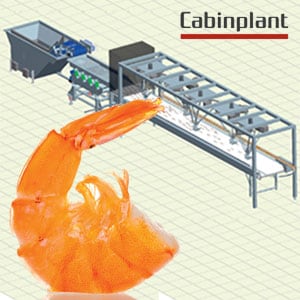The Danish company said its breakthrough equipment means that products are no longer processed in individual linked steps. Instead, process steps are carried out while the fish or seafood is in transit from the conveyor belt to the package.
“All of the processing steps - separation of head and tail, removal of innards - are performed during the pick-and-place operation in which a robot transfers individual products from a feed conveyor into the package,” said a Cabinplant statement.
This eliminates a number of the handling steps required to link individual processing stations in traditional methods, which also take up extra time and space. The new system is an integrated process, with an uninterrupted automation sequence. The company said it sets “new standards in space minimisation and throughput rates”.
Giveaway reductions
The system can also result in a reduction in product giveaway of between 10 and 12 per cent compared to semi-automatic equipment, said Cabinplant R&D director Henning Ingemann Hansen.
This is because the filling process is weight controlled and based totally on data from an optical measurement / weight calculation system. Giveaway is minimised during package filling as the “robot combines products whose joint weights result in a total as close as possible to the minimum weight”, said the company.
Depending upon the product type, size, and weight, the robot can process and package between 40 and 50 products per minute, said the firm.
System design
The compact system is accessible from all sides and consists of a reservoir with an ascending belt, a vibrating belt, a robotics cell with continuous conveyor belt, as well as an image processing system throughout the conveyor belt’s infeed area.
A variable number of integrated Delta 3 robots, all equipped with identical multifunction tools, can access the conveyor belt. A conveyor chain runs on both sides of the belt to deliver and remove the packages. The entire system, including the robots, is designed in stainless steel for ease of cleaning.
The ascending belt carries product from the reservoir onto the vibrating belt. This spreads them out along its width and pre-aligns the individual items. As it reaches the conveyor belt a camera records the position of each individual product and determines its length. Based upon this length, a software algorithm calculates the weight without the use of scales.
Return on investment
The conveyor belt moves product within range of the robot which picks the products individually and uses its multifunction tool to perform all the process steps, said Cabinplant. A cutting tool removes the head and tail – or in the case of shrimps, just the head. A suction tool is inserted to remove the innards. The system calculates the position of each product based upon camera information and belt movements. One vision system is sufficient for up to five robots.

The robot places the fully processed, aligned products into the package that is currently being filled, while it is also moving along the conveyor. The single or multiple robots are capable of filling cans on either side of the conveyor belt. Products can be packed in alternating directions for maximum space efficiency or for improved product presentation.
“The elimination of transfer steps between the process steps saves time,” said Henning Ingemann Hansen . “Moreover, the system is extremely compact relative to its output. According to our calculations, the investment costs for such a machine will be amortized after only one to one-and-a-half years.”
